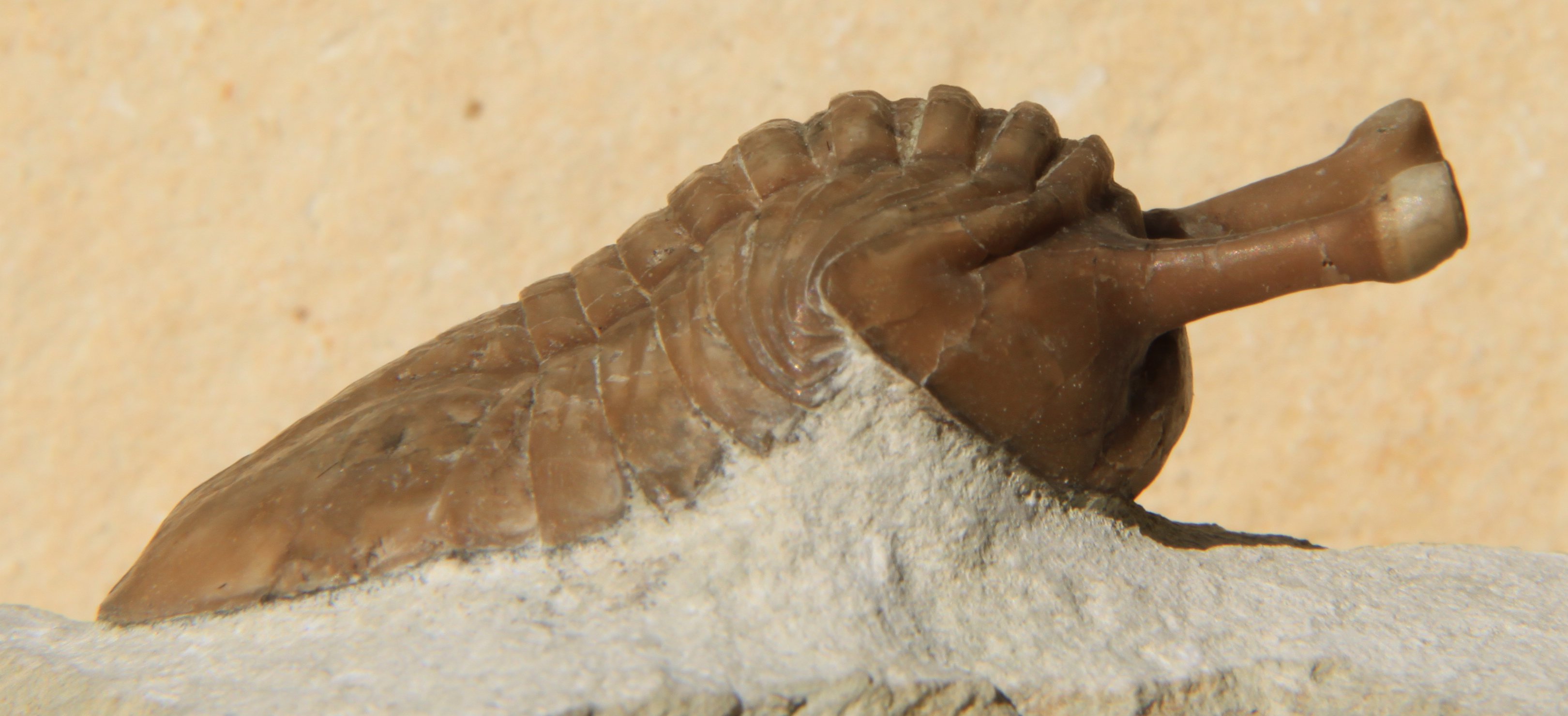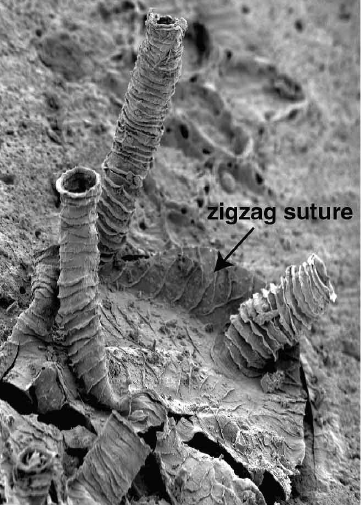|
Llandeilo (age)
In geology, the Llandeilo Group is the middle subdivision of the British Ordovician rocks. It was first described and named by Sir Roderick Murchison from the neighborhood of Llandeilo in Carmarthenshire. In the type area it consists of a series of slaty rocks, shales, calcareous flagstones and sandstones; the calcareous middle portion is sometimes termed the Llandeilo limestone; and in the upper portion volcanic rocks are intercalated. Features A remarkable feature in the history of the Llandeilo rocks in Britain, more especially in North Wales and Cumberland, was the outbreak of volcanic action; vast piles of Llandeilo lava and ashes form such hills as Cadair Idris, and the Arenigs in Wales, and Helvellyn and Scafell in Westmorland and Cumberland. The series is also found at Builth and in Pembrokeshire. The average thickness in Wales is about 2000 ft. The group is usually divided in this area into three sub-divisions. In the Corndon district of Shropshire the Middl ... [...More Info...] [...Related Items...] OR: [Wikipedia] [Google] [Baidu] |
Geology
Geology () is a branch of natural science concerned with Earth and other astronomical objects, the features or rocks of which it is composed, and the processes by which they change over time. Modern geology significantly overlaps all other Earth sciences, including hydrology, and so is treated as one major aspect of integrated Earth system science and planetary science. Geology describes the structure of the Earth on and beneath its surface, and the processes that have shaped that structure. It also provides tools to determine the relative and absolute ages of rocks found in a given location, and also to describe the histories of those rocks. By combining these tools, geologists are able to chronicle the geological history of the Earth as a whole, and also to demonstrate the age of the Earth. Geology provides the primary evidence for plate tectonics, the evolutionary history of life, and the Earth's past climates. Geologists broadly study the properties and processes of E ... [...More Info...] [...Related Items...] OR: [Wikipedia] [Google] [Baidu] |
Westmorland
Westmorland (, formerly also spelt ''Westmoreland'';R. Wilkinson The British Isles, Sheet The British IslesVision of Britain/ref> is a historic county in North West England spanning the southern Lake District and the northern Dales. It had an administrative function from the 12th century until 1974. Between 1974 and 2023 Westmorland lay within the administrative county of Cumbria. In April 2023, Cumbria County Council will be abolished and replaced with two unitary authorities, one of which, Westmorland and Furness, will cover all of Westmorland (as well as other areas), thereby restoring the Westmorland name to a top-tier administrative entity. The people of Westmorland are known as Westmerians. Early history Background At the beginning of the 10th century a large part of modern day Cumbria was part of the Kingdom of Strathclyde, and was known as '' "Scottish Cumberland" ''. The Rere Cross was ordered by Edmund I (r.939-946) to serve as a boundary marker between England an ... [...More Info...] [...Related Items...] OR: [Wikipedia] [Google] [Baidu] |
Cheirurus
''Cheirurus'' (from Greek ''χείρ, cheir'' meaning "hand" and ''ουρά, oura'' meaning "tail") is a genus of phacopid trilobites that lived from the Ordovician to the Devonian. Its remains have been found in Africa, Asia, Australia, Europe, and North America North America is a continent in the Northern Hemisphere and almost entirely within the Western Hemisphere. It is bordered to the north by the Arctic Ocean, to the east by the Atlantic Ocean, to the southeast by South America and the Car .... ''Cheirurus'' is the type genus of Cheiruridae. References * ''Trilobite: Eyewitness to Evolution'' by Richard Fortey External links Trilobites.info in the Paleobiology Database ... [...More Info...] [...Related Items...] OR: [Wikipedia] [Google] [Baidu] |
Calymene Cambrensis
''Calymene'' Brongniart, 1822, is a genus of trilobites in the order Phacopida, suborder Calymenina, that are found throughout North America, North Africa, and Europe in primarily Silurian outcrops. ''Calymene'' is closely related to '' Flexicalymene'', and both genera are frequently found enrolled. Calymene trilobites are small, typically 2 cm in length. The cephalon is the widest part of the animal and the thorax usually has 13 segments. The correct genus authorship is Brongniart (1822). A previously published genus description in Desmarest (1816) (often mis-cited as "Calymena" Desmarest, 1817) was suppressed by ICZN Opinion 1433. Etymology ''Calymene'' - meaning ''beautiful crescent'' as a reference to the glabella. Known species and locations *†'' Calymene blumenbachii'', Dudley, England - Type *†''Calymene brevicapitata'', N. and S. Wales *†''Calymene breviceps'', Indiana and Illinois *†'' Calymene celebra'', Illinois, Indiana, and Wisconsi ... [...More Info...] [...Related Items...] OR: [Wikipedia] [Google] [Baidu] |
Asaphus Tyrannus
''Asaphus'' () is a genus of trilobites that is known from the Lower (upper Arenig) and Middle Ordovician of northwestern Europe (Sweden, Estonia, Saint Petersburg Area). Etymology The generic name is derived from the Greek word ''asaphes'', meaning "indistinct." Description The headshield (or cephalon) and tailshield (or pygidium) are semicircular and without a border (defined by a furrow or a change in convexity parallel to its margin). The cephalon is of approximately equal size as the pygidium (or isopygous). The central raised area of the cephalon (or glabella) is long, reaching the frontal margin. It may have faint lateral glabellar furrows or be smooth, and sometimes an inconspicuous tubercle is present just in front of the hardly discernible occipital ring. The natural fracture lines (sutures) of the head run along the top edges of the compound eye. From the back of the eye these cut to the back of the head (or is said to be opisthoparian) and not to the side. ... [...More Info...] [...Related Items...] OR: [Wikipedia] [Google] [Baidu] |
Ogygiocarella
''Ogygiocarella'' Brongniart, 1822, is a genus of asaphid trilobites. It occurred during the Middle Ordovician. Etymology The generic name, ''Ogygiocarella'', refers to "Ogygia", the seventh daughter of Amphion and Niobe, which name is combined with "-care-", from the Greek "akares", meaning short, and finally "-ella", the diminutive form. History ''Ogygiocarella'' is arguably the first trilobite that was scientifically described. Rev. Edward Lhwyd published in 1698 in The Philosophical Transactions of the Royal Society, the oldest scientific journal in the English language, part of his letter “Concerning Several Regularly Figured Stones Lately Found by Him", that was accompanied by a page of etchings of fossils. One of his etchings figured a trilobite he found near Llandeilo, probably on the grounds of Lord Dynefor's castle, he described as “… the skeleton of some flat Fish …". Distribution * ''O. debuchii'' occurs in the Middle Ordovician of Wales (late Ll ... [...More Info...] [...Related Items...] OR: [Wikipedia] [Google] [Baidu] |
Trilobite
Trilobites (; meaning "three lobes") are extinct marine arthropods that form the class Trilobita. Trilobites form one of the earliest-known groups of arthropods. The first appearance of trilobites in the fossil record defines the base of the Atdabanian stage of the Early Cambrian period () and they flourished throughout the lower Paleozoic before slipping into a long decline, when, during the Devonian, all trilobite orders except the Proetida died out. The last extant trilobites finally disappeared in the mass extinction at the end of the Permian about 252 million years ago. Trilobites were among the most successful of all early animals, existing in oceans for almost 270 million years, with over 22,000 species having been described. By the time trilobites first appeared in the fossil record, they were already highly diversified and geographically dispersed. Because trilobites had wide diversity and an easily fossilized exoskeleton, they left an extensive fossil record. The stu ... [...More Info...] [...Related Items...] OR: [Wikipedia] [Google] [Baidu] |
Diplograptus Foliaceus
''Diplograptus'' was a Cambrian The Cambrian Period ( ; sometimes symbolized C with bar, Ꞓ) was the first geological period of the Paleozoic Era, and of the Phanerozoic Eon. The Cambrian lasted 53.4 million years from the end of the preceding Ediacaran Period 538.8 million ... genus of graptolites. References Graptolite genera Cambrian invertebrates Paleozoic life of Ontario Paleozoic life of New Brunswick Paleozoic life of Newfoundland and Labrador Paleozoic life of the Northwest Territories Paleozoic life of Nunavut Paleozoic life of Quebec Paleozoic life of Yukon {{Cambrian-animal-stub ... [...More Info...] [...Related Items...] OR: [Wikipedia] [Google] [Baidu] |
Climacograptus Scharenbergi
''Climacograptus'' is an Ordovician to Silurian The Silurian ( ) is a geologic period and system spanning 24.6 million years from the end of the Ordovician Period, at million years ago ( Mya), to the beginning of the Devonian Period, Mya. The Silurian is the shortest period of the Paleozo ... genus of graptolites. References Graptolite genera Ordovician animals of North America Silurian animals of North America Paleozoic life of Ontario Bertie Formation Paleozoic life of New Brunswick Paleozoic life of Newfoundland and Labrador Paleozoic life of the Northwest Territories Paleozoic life of Nunavut Paleozoic life of Quebec Paleozoic life of Yukon Ordovician animals of Asia Paleozoic Malaysia Fossils of Malaysia Fossil taxa described in 1974 {{cambrian-animal-stub ... [...More Info...] [...Related Items...] OR: [Wikipedia] [Google] [Baidu] |
Didymograptus
''Didymograptus'' is an extinct genus of graptolites with four rows of cups. They lived during the Middle Ordovician, to Late Ordovician.''Didymograptus'' at Fossilworks
Fossilworks is a portal which provides query, download, and analysis tools to facilitate access to the Paleobiology Database
The Paleobiology Database is an online resource for information on the distribution and classification of fossil animals ... .org
Distribution Fossils of ''Didymograptus'' have been found in Argentina, Australia, Bolivia, Canada (Northwest Territories, Quebec, Yukon, Newfoundland and Labrador), Chile, China, Colombia ([...More Info...] [...Related Items...] OR: [Wikipedia] [Google] [Baidu] |
Graptolite
Graptolites are a group of colonial animals, members of the subclass Graptolithina within the class Pterobranchia. These filter-feeding Filter feeders are a sub-group of suspension feeding animals that feed by straining suspended matter and food particles from water, typically by passing the water over a specialized filtering structure. Some animals that use this method of feedin ... organisms are known chiefly from fossils found from the Middle Cambrian (Miaolingian, Wuliuan) through the Lower Carboniferous (Mississippian (geology), Mississippian). A possible early graptolite, ''Chaunograptus'', is known from the Middle Cambrian. Recent analyses have favored the idea that the living pterobranch ''Rhabdopleura'' represents an extant graptolite which diverged from the rest of the group in the Cambrian. Fossil graptolites and ''Rhabdopleura'' share a colony structure of interconnected zooids housed in organic tubes (theca) which have a basic structure of stacked half-rings (fuse ... [...More Info...] [...Related Items...] OR: [Wikipedia] [Google] [Baidu] |


.jpg)
